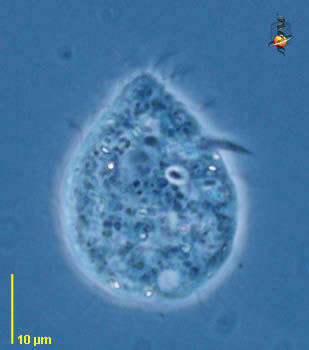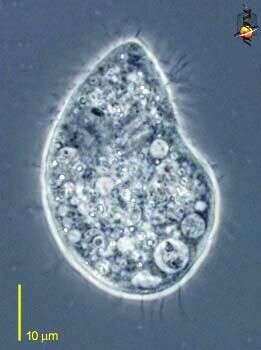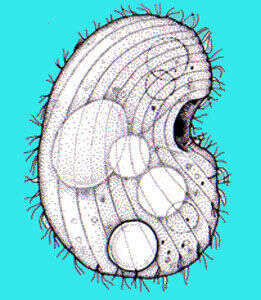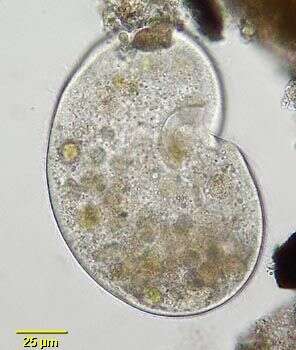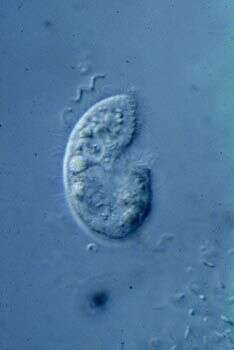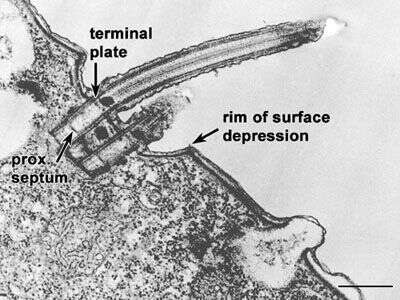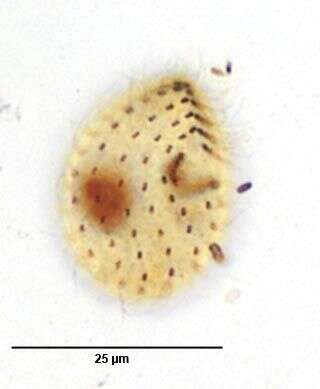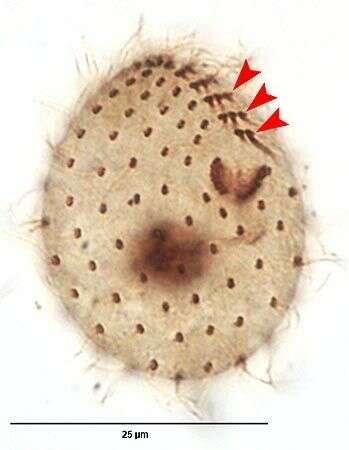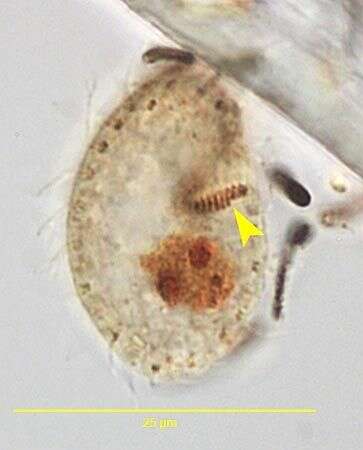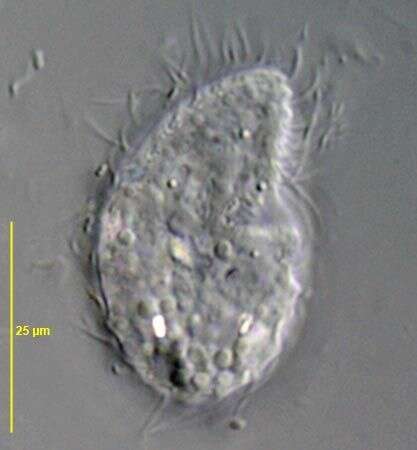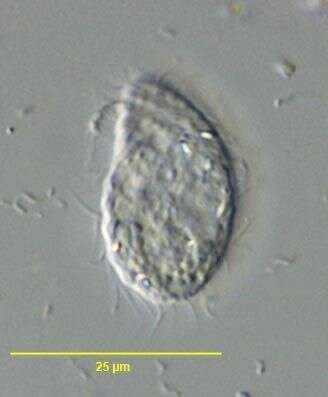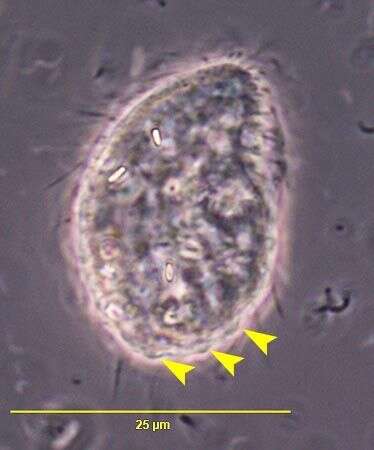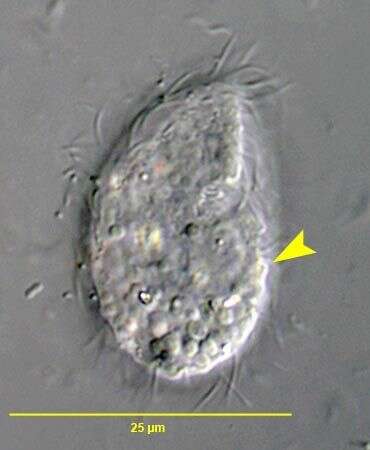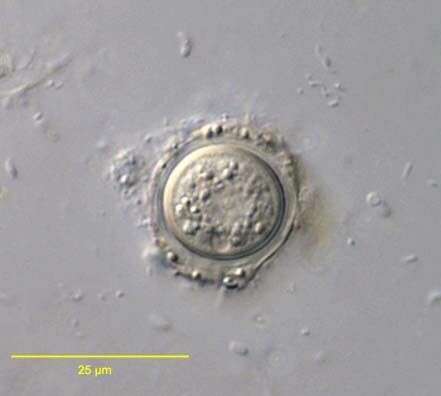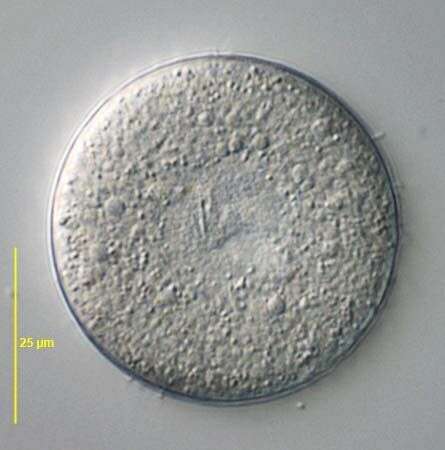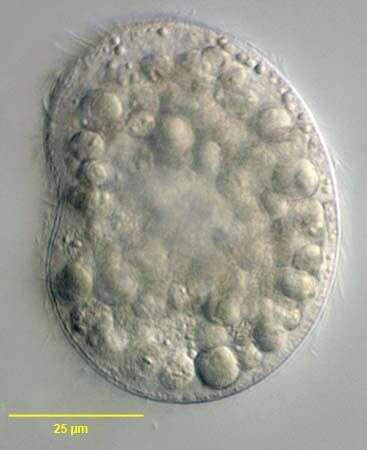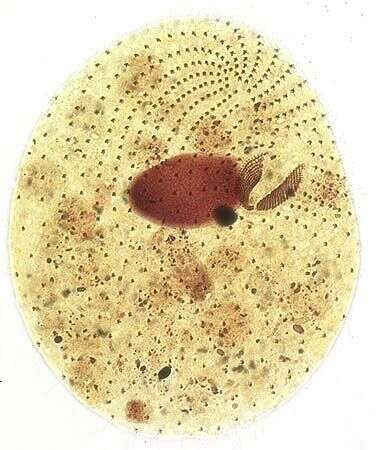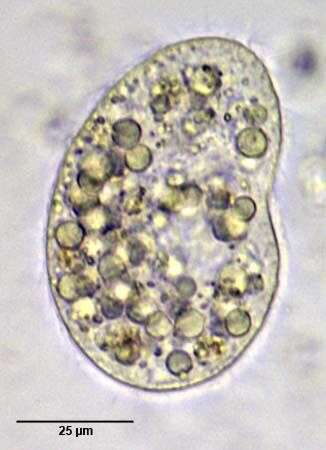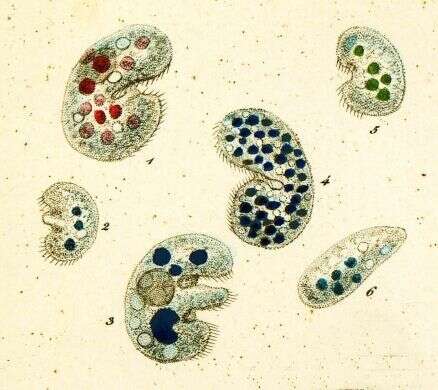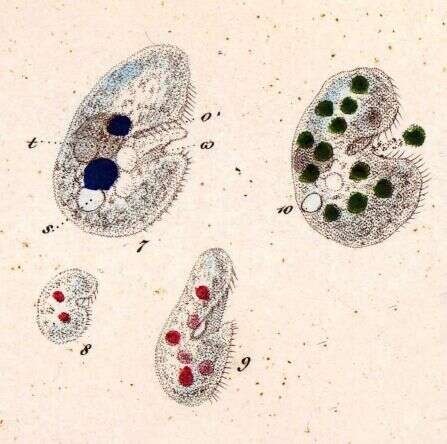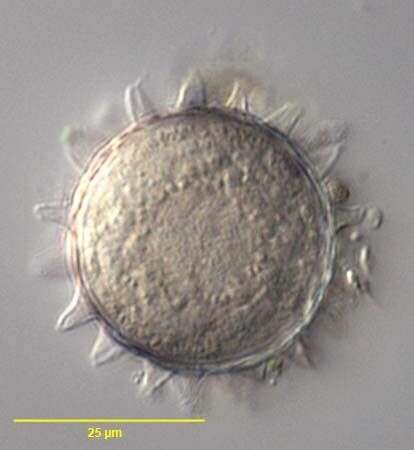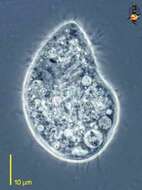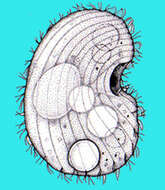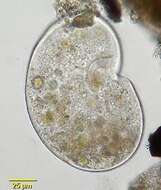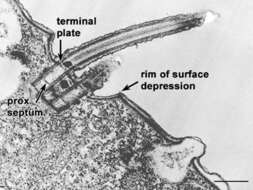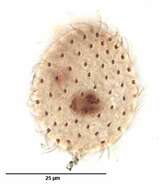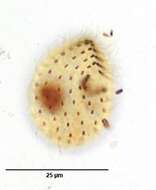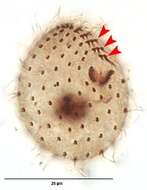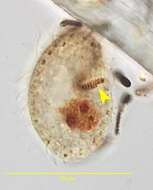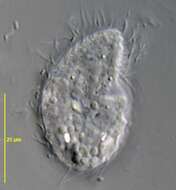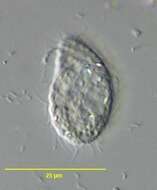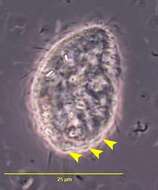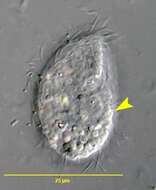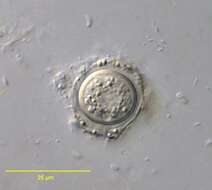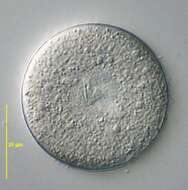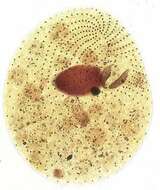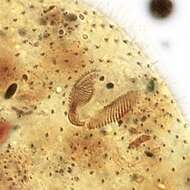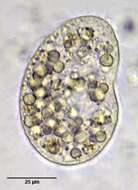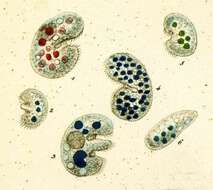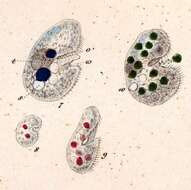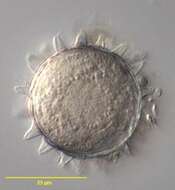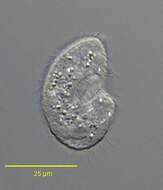-
Colpoda (col-poe-da) is arguably the most common of all soil ciliates. Comma-shaped, flattened, cilia all over body. Cilia usually in pairs. Depression of body leads to the mouth region where there are lines of oral cilia. these cilia may clump together and are longer than the cilia of the rest of the body - as this micrograph illustrates. Usually eats bacteria. Can form cysts which resist drying up. Phase contrast.
-
Colpoda (col-poe-da) is arguably the most common of all soil ciliates. Comma-shaped, flattened, cilia all over body. Cilia usually in pairs. Depression of body leads to the mouth region where there are lines of oral cilia - seen in this micrograph a little way 2 o clock from the centre of the cell. Usually eats bacteria. Can form cysts which resist drying up. Phase contrast.
-
-
Colpoda, a common soil ciliate. There are many species. Tillina is now considered synonymous with Colpoda. This species is large, reniform and slightly flattened with uniform ciliation. A distinct, fairly wide groove (not seen in this view) runs obliquely and inferiorly to the left from the oral apparatus. Prominent extrusomes are present. The contractile vacuole is posterior with many thin anteriorly radiating collecting canals (not seen in this image). Macronucleus is ellipsoid. Many food vacuoles can be seen in this image. Mainly bactivorous. Forms both reproductive and resting cysts. Cysts have remained viable after desiccation for up to 10 years. Right lateral view. From temporary rainwater pool in grass field near Boise, Idaho. Brightfield.
-
Single Colpoda cell, isolated from a soil sample in W. England.
-
Dikinetids (see Lynn, Biol. Rev. 56:243-292, 1981, for discussion of kinetids in ciliates) are set in a shallow basin in the cell surface that has a fairly sharp rim at its margin. The basal bodies have a proximal cartwheel and a dense septum (not found in most bbs) just distal to this cartwheel. The terminal plate separates the basal body from the cilium that arises from the distal end of the basal body. EM taken on 5/31/69 by R. Allen with Philips 300 TEM. Neg. 14,800X. Bar = 0.5 micron.
This image is available in Richard Allen's collection.
-
Dorsal infraciliature of Colpoda aspera (KAHL,1926). From a non-flooded Petri dish culture of tree bark collected in Boise,Idaho.January 2007. Stained by the silver carbonate technique (Foissner, W.Europ. J. Protistol.27:313-330;1991).Brightfield.
-
Right ventrolateral infraciliature of Colpoda aspera (KAHL,1926). From a non-flooded Petri dish culture of tree bark collected in Boise,Idaho.January 2007. Stained by the silver carbonate technique (Foissner, W.Europ. J. Protistol.27:313-330;1991).Brightfield.
-
Right ventrolateral infraciliature of Colpoda aspera (KAHL,1926).The red arrowheads indicate long densely-impregnated fibrillar structures arising from the anterior dikinetids of left lateral somatic kineties. Thes may represent coalesced transverse microtubular ribbons of the posterior basal bodies of the dikinetids (LKm fiber). From a non-flooded Petri dish culture of tree bark collected in Boise,Idaho.January 2007. Stained by the silver carbonate technique (Foissner, W.Europ. J. Protistol.27:313-330;1991).Brightfield.
-
Left oral polykinetid of Colpoda aspera (KAHL,1926). The yellow arrowhead indicates the "notch" in the lateral end of the polykinetid. This results from the laterals-most 3 kineties having fewer basal bodies than the more medial kineties of the polykinetid. Foissner has identified this as a characteristic feature of this species (Foissner,W. Colpodea (Ciliophora).Gustav Fischer Verlag,Stuttgart,1993, pp. 97-100).From a non-flooded Petri dish culture of tree bark collected in Boise,Idaho.January 2007. Stained by the silver carbonate technique (Foissner, W.Europ. J. Protistol.27:313-330;1991).Brightfield. .
-
Right ventrolateral view of Colpoda aspera (KAHL,1926). From a non-flooded Petri dish culture of tree bark collected in Boise,Idaho.January 2007.DIC.
-
Dorsal view of Colpoda aspera (KAHL,1926). From a non-flooded Petri dish culture of tree bark collected in Boise,Idaho.January 2007. Stained by the silver carbonate technique (Foissner, W.Europ. J. Protistol.27:313-330;1991).DIC.
-
Right ventrolateral view of Colpoda aspera (KAHL,1926). The yellow arrow heads indicate the lobular pellicular protuberances that give the cell margin a serrated or scalloped appearance, especially posteriorly.From a non-flooded Petri dish culture of tree bark collected in Boise,Idaho.January 2007. Stained by the silver carbonate technique (Foissner, W.Europ. J. Protistol.27:313-330;1991).Phase contrast.
-
Right ventrolateral view of Colpoda aspera (KAHL,1926). The yellow arrowhead indicates one of the lobular/conical pellicular protuberances that give the cell margin a serrated or scalloped appearance, especially posteriorly.From a non-flooded Petri dish culture of tree bark collected in Boise,Idaho.January 2007. Stained by the silver carbonate technique (Foissner, W.Europ. J. Protistol.27:313-330;1991).DIC.
-
Resting cyst of Colpoda aspera (KAHL,1926). From a non-flooded Petri dish culture of maple tree (Acer sp.) bark collected in Boise,Idaho.January 2007.DIC.
-
Young (~3 day old) resting cyst of Colpoda cucullus.Collected from non-flooded Petri dish culture of bark from the bitterbrush tree (Purshia tridentata).Boise,Idaho.February 2007).DIC.
-
in vivo view of (MColpoda cucullus (MÃlLLER,1773) GMELIN,1790 (left side).Collected from non-flooded Petri dish culture of bark from the bitterbrush tree (Purshia tridentata).Boise,Idaho.February 2007).DIC.
-
Infraciliature of Colpoda cucullus (MÃlLLER,1773) GMELIN, 1790 (right ventrolateral view). Stained by the silver carbonate technique (Foissner,W. Europ. J. Protistol.27:313-330;1991).Collected from non-flooded Petri dish culture of bark from the bitterbrush tree (Purshia tridentata).Boise,Idaho.February 2007).Brightfield.
-
Oral infraciliature of Colpoda cucullus (MÃlLLER,1773) GMELIN, 1790 (right ventrolateral view). Stained by the silver carbonate technique (Foissner,W. Europ. J. Protistol.27:313-330;1991).Collected from non-flooded Petri dish culture of bark from the bitterbrush tree (Purshia tridentata).Boise,Idaho.February 2007).Brightfield.
-
in vivo view of Colpoda cucullus (MÃlLLER,1773) GMELIN,1790 (right side).Collected from non-flooded Petri dish culture of bark from the bitterbrush tree (Purshia tridentata).Boise,Idaho.February 2007).Brightfield,condenser closed.
-
Originally described by Ehrenberg under the name Kolpoda cucullus.
-
Originally described by Ehrenberg under the name Kolpoda cucullus.
-
Resting cyst of Colpoda flavicans (STOKES,1885) FOISSNER,1993. DIC.
-
Right lateral view of Colpoda inflata (Stokes,1884) Kahl, 1931.Collected from a temporary rainwater pool with abundant decaying grass near Boise, Idaho December 2005.DIC.


